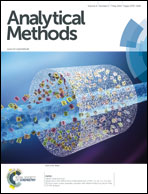The study of reduced versus oxidized glutathione in cancer cell models employing isotopically labelled standards
Abstract
In this work, LC-MS/MS assays for accurate quantification of underivatized glutathione (GSH) and its oxidized form glutathione disulfide (GSSG) were developed based on isotope dilution. Both hydrophilic interaction (HILIC) and reversed phase chromatography (RPC) were implemented. Different protocols dedicated to cancer cell lysis were validated in terms of extraction efficiency, recovery, and unwanted glutathione oxidation. The latter was monitored using isotopologues of GSSG, which were formed upon reaction with isotopically enriched GSH and natural GSH of the sample. Finally, LC-MS/MS was employed for studying the GSH : GSSG ratios in several cancer cells (HCT116, GLC4, and SW480) upon exposure to anticancer metallodrugs. Clinically well-established cis-diamine-dichloro-platinum(II) (cisplatin) and sodium trans-[tetrachloridobis(1H-indazole)ruthenate(III)] (KP1339), promising experimental drugs, were addressed. In both cases, a decrease of the GSH : GSSG ratio was observed upon drug exposure. It was more pronounced for cisplatin, where the ratio shifted from 440 : 1 to 240 : 1 and from 160 : 1 to 90 : 1 in HCT116 and GLC4 cells, respectively. For KP1339, a significant decrease was observed in the SW480 cancer cell model, whereas the change was not significant in HCT116 cells. Taken together, this study introduces a new sensitive and robust method for the evaluation of drug-induced changes in the intracellular GSH : GSSG ratio of human cells.


 Please wait while we load your content...
Please wait while we load your content...